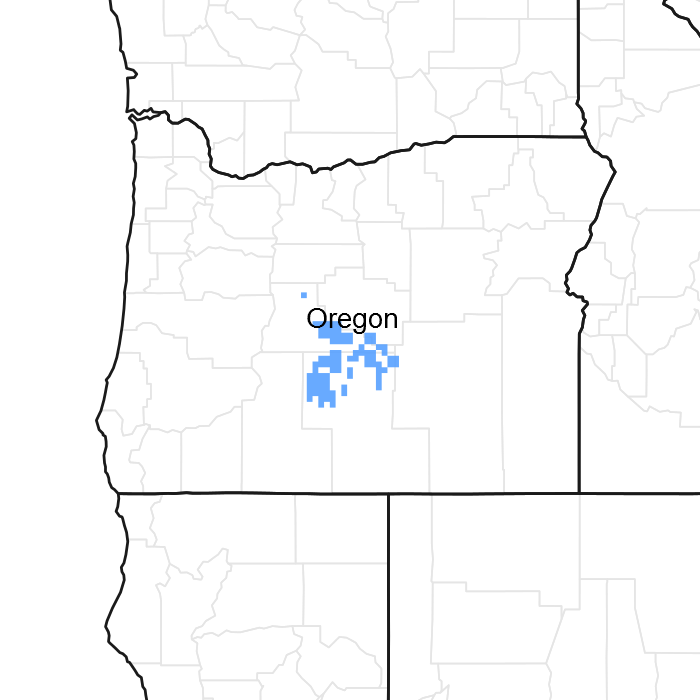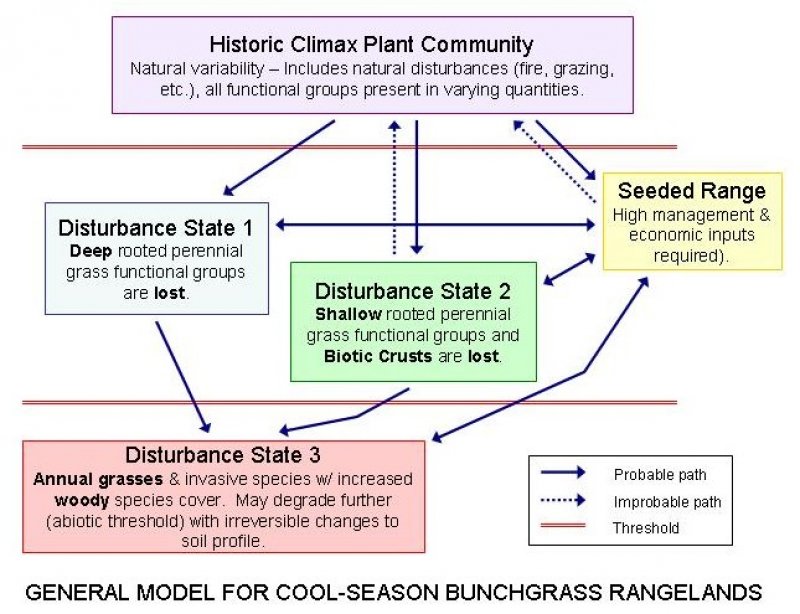
Natural Resources
Conservation Service
Ecological site R010XA026OR
Juniper Pumice North 10-12 PZ
Last updated: 4/10/2025
Accessed: 12/19/2025
General information
Provisional. A provisional ecological site description has undergone quality control and quality assurance review. It contains a working state and transition model and enough information to identify the ecological site.

Figure 1. Mapped extent
Areas shown in blue indicate the maximum mapped extent of this ecological site. Other ecological sites likely occur within the highlighted areas. It is also possible for this ecological site to occur outside of highlighted areas if detailed soil survey has not been completed or recently updated.
Associated sites
| R010XA007OR |
Juniper Pumice South 9-12 PZ |
|---|---|
| R010XA025OR |
Juniper Shallow North 10-12 PZ |
Similar sites
| R010XA083OR |
Juniper Shrubby North 9-12 PZ |
|---|---|
| R010XA025OR |
Juniper Shallow North 10-12 PZ |
Table 1. Dominant plant species
| Tree |
(1) Juniperus occidentalis var. occidentalis |
|---|---|
| Shrub |
(1) Artemisia tridentata ssp. vaseyana |
| Herbaceous |
(1) Festuca idahoensis |
Physiographic features
This site occurs on moderate to steep, north facing slopes of buttes and ridges.
Table 2. Representative physiographic features
| Landforms |
(1)
Butte
(2) Ridge |
|---|---|
| Flooding frequency | None |
| Ponding frequency | None |
| Elevation | 2,800 – 5,500 ft |
| Slope | 20 – 65% |
| Aspect | N |
Climatic features
The annual precipitation ranges from 10 to 12 inches which occurs mainly between the months of November and June, mostly in the form of rain and snow. The soil temperature regime is frigid. The average annual air temperature is 43 degrees F with extreme temperatures ranging from -30 to 103 degrees F. The frost free period is 50 to 90 days. The optimum period for plant growth is from April through July.
Table 3. Representative climatic features
| Frost-free period (average) | 90 days |
|---|---|
| Freeze-free period (average) | |
| Precipitation total (average) | 12 in |
Influencing water features
Soil features
The soils of this site are moderately deep and will drained. They contain volcanic ash in the surface and have medium textured subsoils. They are generally formed from volvanic ash and the underlying residuum or bedrock. Permeability is moderately slow and the available water holding capacity is 2 to 4 inches for the profile. The potential for water erosion is low, and for wind erosion low to high.
Table 4. Representative soil features
| Drainage class | Well drained |
|---|---|
| Permeability class | Moderately slow |
| Soil depth | 40 in |
| Available water capacity (0-40in) |
2 – 4 in |
Ecological dynamics
Juniper and sagebrush decrease following burning while rabbitbrush incrases after burning. Overgrazing causes a decline in Idaho fescue and bluebunch wheatgrass, and an increase in squirreltail.
Increasers and invaders on this site include cheatgrass, mustard, collinsia, micosteris, woolypod milkvetch, rock cress, grey rabbitbrush, and prickly gilia.
Juniper cover and bluebunch wheatgrass increases in the stand where stoniness increases.
State and transition model

More interactive model formats are also available.
View Interactive Models
More interactive model formats are also available.
View Interactive Models
Click on state and transition labels to scroll to the respective text
Ecosystem states
State 1 submodel, plant communities
State 1
Reference
Community 1.1
Reference Plant Community
The potential native plant community is domiated by western juniper, big sagebrush and Idaho fescue. Bluebunch wheatgrass is abundant alon with lesser amounts of Sandberg bluegrass, Junegrass, big bluegrass and a variety of forbs. Minor occurrences of bitterbrush, gray horsebrush, and small green rabbitbrush are also present.
Figure 2. Annual production by plant type (representative values) or group (midpoint values)
Table 5. Annual production by plant type
| Plant type | Low (lb/acre) |
Representative value (lb/acre) |
High (lb/acre) |
|---|---|---|---|
| Grass/Grasslike | 490 | 630 | 770 |
| Shrub/Vine | 105 | 135 | 165 |
| Forb | 70 | 90 | 110 |
| Tree | 35 | 45 | 55 |
| Total | 700 | 900 | 1100 |
Figure 3. Plant community growth curve (percent production by month). OR4031, B10A Mesic, Mid Elev., North, Good Condition. B10A Mesic, Mid Elev., North, Good Condition RPC Growth Curve.
| Jan | Feb | Mar | Apr | May | Jun | Jul | Aug | Sep | Oct | Nov | Dec |
|---|---|---|---|---|---|---|---|---|---|---|---|
| J | F | M | A | M | J | J | A | S | O | N | D |
| 0 | 0 | 0 | 5 | 25 | 40 | 25 | 5 | 0 | 0 | 0 | 0 |
Additional community tables
Table 6. Community 1.1 plant community composition
| Group | Common name | Symbol | Scientific name | Annual production (lb/acre) | Foliar cover (%) | |
|---|---|---|---|---|---|---|
|
Grass/Grasslike
|
||||||
| 1 | Dominant deep rooted perennial grasses | 360–540 | ||||
| Idaho fescue | FEID | Festuca idahoensis | 360–540 | – | ||
| 2 | Sub-dominant deep rooted perennial grasses | 144–252 | ||||
| bluebunch wheatgrass | PSSP6 | Pseudoroegneria spicata | 135–225 | – | ||
| Thurber's needlegrass | ACTH7 | Achnatherum thurberianum | 9–27 | – | ||
| 4 | Sub-dominant shallow rooted perennial grasses | 27–117 | ||||
| Sandberg bluegrass | POSE | Poa secunda | 18–90 | – | ||
| prairie Junegrass | KOMA | Koeleria macrantha | 9–27 | – | ||
|
Forb
|
||||||
| 7 | Dominant perennial forbs | 9–27 | ||||
| common yarrow | ACMI2 | Achillea millefolium | 9–27 | – | ||
| 8 | Sub-dominant perennial forbs | 36–72 | ||||
| milkvetch | ASTRA | Astragalus | 9–18 | – | ||
| tapertip hawksbeard | CRAC2 | Crepis acuminata | 9–18 | – | ||
| fleabane | ERIGE2 | Erigeron | 9–18 | – | ||
| phlox | PHLOX | Phlox | 9–18 | – | ||
| 9 | Other perennial forbs | 9–54 | ||||
| agoseris | AGOSE | Agoseris | 0–5 | – | ||
| western pearly everlasting | ANMA | Anaphalis margaritacea | 0–5 | – | ||
| Indian paintbrush | CASTI2 | Castilleja | 0–5 | – | ||
| snow buckwheat | ERNI2 | Eriogonum niveum | 0–5 | – | ||
| flax | LINUM | Linum | 0–5 | – | ||
| desertparsley | LOMAT | Lomatium | 0–5 | – | ||
|
Shrub/Vine
|
||||||
| 11 | Dominant evergreen shrubs | 90–135 | ||||
| mountain big sagebrush | ARTRV | Artemisia tridentata ssp. vaseyana | 90–135 | – | ||
| 12 | Sub-dominant evergreen shrubs | 9–18 | ||||
| green rabbitbrush | ERTE18 | Ericameria teretifolia | 9–18 | – | ||
| 15 | Other shrubs | 9–27 | ||||
| slender buckwheat | ERMI4 | Eriogonum microthecum | 0–9 | – | ||
| antelope bitterbrush | PUTR2 | Purshia tridentata | 0–9 | – | ||
| desert gooseberry | RIVE | Ribes velutinum | 0–9 | – | ||
| horsebrush | TETRA3 | Tetradymia | 0–9 | – | ||
|
Tree
|
||||||
| 16 | Dominant evergreen trees | 45–90 | ||||
| western juniper | JUOC | Juniperus occidentalis | 45–90 | – | ||
Interpretations
Animal community
Mule deer use this site in late spring, summer and fall. Winter use is made of the site in open, mild winter.
Hydrological functions
The soils of this site have high infiltration rates and low runoff potential.
Wood products
Juniper firewood and posts.
Other products
Late season grazing in mid summr and fall will be concentrated on Idaho fescue and Thurber needlegrass, rather than bluebunch wheatgrass.
Other information
Recommeded species for range seedings include crested wheatgrass, pubescent wheatgrass, Siberian wheatgrass, big bluegrass, sheep fescue, and bluebunch wheatgrass.
Supporting information
Other references
B10B Site also similar to this site:
Droughty North 9-12 PZ #010XB084OR
Contributors
Cici Brooks
E Ersch
Gene Hickman
K.Kennedy
Approval
Kirt Walstad, 4/10/2025
Rangeland health reference sheet
Interpreting Indicators of Rangeland Health is a qualitative assessment protocol used to determine ecosystem condition based on benchmark characteristics described in the Reference Sheet. A suite of 17 (or more) indicators are typically considered in an assessment. The ecological site(s) representative of an assessment location must be known prior to applying the protocol and must be verified based on soils and climate. Current plant community cannot be used to identify the ecological site.
| Author(s)/participant(s) | Jeff Repp and Bruce Franssen |
|---|---|
| Contact for lead author | State Rangeland Management Specialist |
| Date | 08/03/2012 |
| Approved by | Kirt Walstad |
| Approval date | |
| Composition (Indicators 10 and 12) based on | Annual Production |
Indicators
-
Number and extent of rills:
None, Slight sheet & rill erosion hazard -
Presence of water flow patterns:
None to some on steeper slopes -
Number and height of erosional pedestals or terracettes:
None to some on steeper slopes -
Bare ground from Ecological Site Description or other studies (rock, litter, lichen, moss, plant canopy are not bare ground):
5-10% -
Number of gullies and erosion associated with gullies:
None -
Extent of wind scoured, blowouts and/or depositional areas:
None to some, Slight to severe wind erosion hazard -
Amount of litter movement (describe size and distance expected to travel):
Fine - limited movement -
Soil surface (top few mm) resistance to erosion (stability values are averages - most sites will show a range of values):
Moderately resistant to erosion; aggregate stability = 3-5 -
Soil surface structure and SOM content (include type of structure and A-horizon color and thickness):
Moderately deep, well drained gravelly loamy sands (volcanic ash); low OM (1-2%) -
Effect of community phase composition (relative proportion of different functional groups) and spatial distribution on infiltration and runoff:
Significant ground cover (70-85%) and moderate to steep slopes (20-65%) moderately limit rainfall impact and overland flow -
Presence and thickness of compaction layer (usually none; describe soil profile features which may be mistaken for compaction on this site):
None -
Functional/Structural Groups (list in order of descending dominance by above-ground annual-production or live foliar cover using symbols: >>, >, = to indicate much greater than, greater than, and equal to):
Dominant:
Idaho fescue >Sub-dominant:
Other:
Additional:
-
Amount of plant mortality and decadence (include which functional groups are expected to show mortality or decadence):
Normal decadence and mortality expected -
Average percent litter cover (%) and depth ( in):
-
Expected annual annual-production (this is TOTAL above-ground annual-production, not just forage annual-production):
Favorable: 1100, Normal: 900, Unfavorable: 700 lbs/acre/year at high RSI (HCPC) -
Potential invasive (including noxious) species (native and non-native). List species which BOTH characterize degraded states and have the potential to become a dominant or co-dominant species on the ecological site if their future establishment and growth is not actively controlled by management interventions. Species that become dominant for only one to several years (e.g., short-term response to drought or wildfire) are not invasive plants. Note that unlike other indicators, we are describing what is NOT expected in the reference state for the ecological site:
Perennial brush species will increase with deterioration of plant community. Western Juniper readily increases on the site. Cheatgrass and Medusahead invade sites that have lost deep rooted perennial grass functional groups. -
Perennial plant reproductive capability:
All species should be capable of reproducing annually
Print Options
Sections
Font
Other
The Ecosystem Dynamics Interpretive Tool is an information system framework developed by the USDA-ARS Jornada Experimental Range, USDA Natural Resources Conservation Service, and New Mexico State University.
Click on box and path labels to scroll to the respective text.